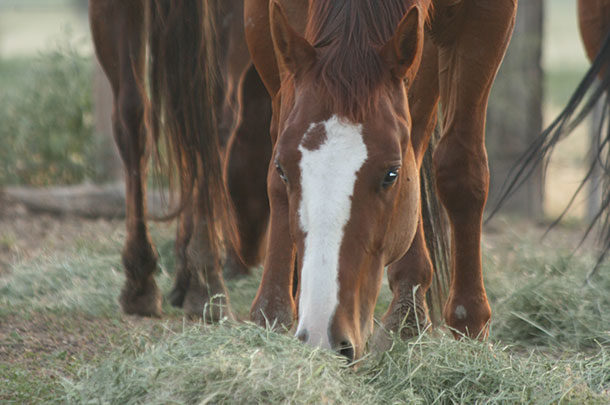One of the biggest differences in producing hay for the horse market is: Many owners are looking for small square bales rather than large square or round bales. This is sometimes due to storage space limitations as well as the large number of horse owners who are on small properties and have limited equipment availability for moving the larger hay packages.
Additionally, horses are usually managed quite differently than most livestock. Depending on your location in the U.S., there are a large number of horses kept in stalls for at least part of the day, requiring hay to be fed in smaller amounts.
Nutrition is also an important part of managing any horse facility. Non-structural carbohydrates (NSC) have been in the equine news a lot lately, mainly due to their involvement in laminitis and obesity issues.
NSC are the soluble cell components, such as sugar, starch and fructans, and are readily available sources of energy. They can be broken down by mammalian enzymes and absorbed prior to reaching the hindgut.
The hindgut is the part of the large intestine (cecum) that houses large numbers of microbes able to digest structural carbohydrates, like cellulose and hemicellulose, which mammals otherwise don’t have the ability to break down. This process is similar to what happens in the rumen of a cow or sheep.
However, if too much NSC reaches the hindgut, it can create issues with the microbial populations. Many times, this can lead to a laminitic or otherwise problematic health event.
Owners have been looking for lower-energy and reduced-NSC hays to feed to their horses to prevent both obesity and laminitis. There are many types of forages typically lower in NSC and energy, often including warm-season grasses like teff hay or cool-season grasses that have been cut at a later stage of maturity.
This is because as a forage (such as timothy, alfalfa or bermudagrass) matures, the percentage of structural carbohydrates increases, while the percentage of NSC, protein and other nutrients decreases.
For many low-maintenance horses (namely, the overweight horse population), fiber is a very important part of the ration, and more mature forages and forages with lower digestibility can be a good source of that, as well.
If a producer is in an area with horses that are used mainly for recreation in low levels of work, it might be a good idea to consider marketing this type of hay.
On the other hand, there are many horses that need high energy-dense forages. Horses in heavy work, such as racehorses, eventers or hardworking ranch horses, as well as horses that are lactating and gestating, will especially require higher energy and protein intakes.
This can be achieved by doing the opposite of the above – harvesting the forage at an earlier maturity or including species that have the ability to produce higher energy and protein.
The most common example is alfalfa, although other legumes such as sainfoin, birdsfoot trefoil and clovers will give similar results. So if you are in an area with a lot of breeding farms or high-level performance farms and ranches, producing hay with higher nutrient densities would likely be a better option.
Building relationships with your buyers will help to ensure consistency from year to year. A research survey out of the University of Reno found that horse owners find consistency in visual appearance, species, maturity, weed presence, hay smell and texture to all be important parameters in the hay-purchasing process.
If a relationship exists between a horse owner and producer, this consistency will be much easier to achieve.
There is also a nutritional basis for hay consistency. Research has found horses that have abrupt changes in diet, even if it is just from one hay lot to the next, can have an increased chance of colic.
Keeping hay lots as consistent as possible from one year to the next, as well as from one cutting to the next, will help to reduce this risk.
Finally, anti-quality factors are also very important to owners. Presence of weeds or mold can deter an owner from purchasing hay. Some weeds can be toxic to horses – more so than to their ruminant counterparts.
For example, in Montana it appears that the weed hoary alyssum (Berteroa incana L.) is increasing in abundance. If included at more than 10 percent of the ration, it can create problems with limb edema (stocking up) and diarrhea, among other signs of toxicity. It is not known to have any negative impacts on ruminants.
Mold is especially a problem for horse owners, as horses are known to be more susceptible to mold than ruminants. Mold can create a respiratory issue known as recurrent airway obstruction, or heaves, as well as negatively impacting reproductive performance.
If mold becomes a significant problem in the hay, which can happen during baling or storage, it is advised to have hay tested or feed it to less-susceptible ruminants. Hay that has been “put up wet” or at moisture levels greater than 20 percent, or are in contact with a moist surface like soil, typically have a higher risk for mold.
Levels under 500,000 colony-forming units are considered low-risk, while levels at 1 to 2 million colony-forming units are advised to “feed with caution.” Above those levels, you will need to consider diluting the hay being fed and watching animals closely for any signs of mold toxicity.
Knowing your market is key to knowing what sort of hay is needed. Creating a producer-buyer relationship begins with asking the right questions, knowing your market and having a good understanding of what the horse and horse owner’s needs are.
This will foster a great hay-buying outlet for most producers. Putting up quality hay that can meet horses’ requirements with minimal anti-quality factors will produce a product that the horse industry is searching for. ![]()
PHOTO: Horses eating hay. Photo by Paul Marchant.

-
Emily Glunk
- Extension Forage Specialist and Assistant Professor
- Montana State University.
- Email Emily Glunk












